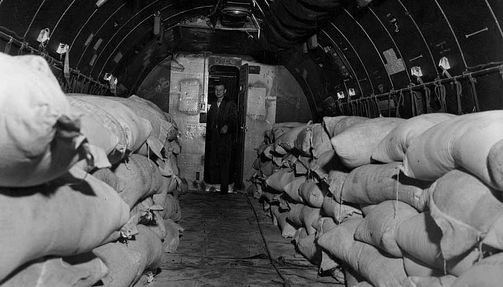The Berlin Blockade challenged the Allied powers and marked the beginning of Cold War-era instability. In the aftermath of World War II, tensions were running high between the Soviet Union and its Western rivals. The divided city of Berlin came to represent the international conflict and struggles for control.
After WWII’s Allied victory, the victors determined Germany’s postwar status in the Potsdam Agreement, which was struck in August 1945. This agreement dictated that defeated Germany would be divided into four zones, each controlled by a victor nation: the United States, Britain, France, and the Soviet Union. The capital city of Berlin was divided, too.
Related: Checkpoint Charlie: That Time American and Soviet Tanks Faced Off in a Divided Berlin
The Allied powers controlled West Berlin while the USSR controlled the East, with the famous wall eventually separating each side and leaving the citizenry in shambles. As a move to push the Allies out of Berlin, the Soviet Union enacted a blockade that would become the first notable Cold War event.
The Berlin Wall wasn't just a physical barrier, but the manifestation of an ideological division: democracy vs authoritarianism; capitalism vs socialism. The city quickly became the political focus of the Western Allies and the Soviet Union alike, as many believed that the prevailing economic system in Berlin would then become that of Germany and Europe as a whole. Furthermore, East Berliners voted en masse against communist leaders in the 1946 elections, giving the Allies political ammunition. The United States had independently determined that a unified Germany would fall to Soviet control if it met Soviet negotiation terms, encouraging the US to unify Germany under Allied control in a West German state. As a result, Britain, the US, and France coordinated to unite their three German zones under a single economic and political plan.
Related: 10 Must-Read Cold War Books
The Soviet Union established a political party, the Socialist Unity Party (SED), that they enforced as the only permitted political activity in Soviet-occupied Germany, insisting that it would not have Marxist-Leninist policies or Soviet orientation. Yet in a meeting with communist leaders in Germany, Stalin declared his plan to undermine British presence in post-war Germany and for the US to leave the region within one or two years, stating his ultimate goal of a communist Germany in explicit terms. To execute this plan, the Soviets in East Berlin got to work limiting the Allies' access to West Berlin.

C-47 aircraft parked in front of the terminal at Tempelhof Central Airport during the Berlin Airlift and the Berlin Blockade.
Photo Credit: Wikimedia CommonsIn June 1948, Stalin initiated the blockade by halting all traffic to Berlin via the autobahn, delaying freight shipments, and requiring that water transport be specially approved. The Soviets also launched a widespread propaganda campaign against the Allies, encouraging communist organizers to riot and attack pro-Western leaders. The Soviet guards ultimately cut off all surface access to West Berlin, leaving only air traffic corridors as a method to get supplies into the region. The Soviets believed that the US, Britain, and France would have no choice but to cede West Berlin.
Meanwhile, the US and Britain were planning to execute a larger-than-life airlift to transport nearly 3,500 tons of supplies into Berlin daily, circumventing the surface travel restrictions by using the three contracted air travel corridors over the city. The airlift began with the expectation that it would last only three weeks. As the fleet grew and more tons of supplies were dropped in Berlin each day, it became clear that this operation would be much more extensive, ultimately lasting a little over a year.

After loading of the C-54 air transport plane with sacks of flour by displaced Polish persons, German civilian personnel, and crewmembers of the plane prepares to take off from Rhine Main Airfield, Germany for Templehof Airbase in Berlin.
Photo Credit: Wikimedia CommonsSoviet responses were frantic, as they began to realize that the Western armies were able to execute the seemingly impossible task of supporting West Berlin by air alone. As a result, Soviet powers offered West Berliners free food if they crossed into East Berlin and secured ration cards. While some West Berliners rejected Soviet supplies, this ploy led to corruption in the West Berlin police forces, leading to a purge of any officers who accepted Soviet rations due to conflict of interest concerns. The Soviet army also tried to disrupt the airlift by harassing Allied aircraft, buzzing planes and shining bright searchlights to disrupt their journeys into Berlin.
Related: The Communist Soldier Who Escaped Through the Berlin Wall in an Armored Personnel Carrier
In light of the continued Allied success with the airlift, the Soviets communicated a willingness to end the blockade in April 1949, opening negotiations with the US, Britain, and France. The blockade was finally lifted on May 12, 1949, followed by immediate surface transport access to West Berlin and widespread celebration by Berliners on both sides of the divide. The airlift continued, albeit less urgently, to build up a three-month surplus of supplies. These flights eventually ended in late July once this surplus had been amassed and the Western powers felt they had a suitable buffer if the need arose.
The conflict in Germany was far from over; the Berlin Wall would be constructed 12 years later in 1961. However, the end of the Berlin Blockade marked a victory for the West and set the tone for the Cold War. Though tensions remain between the US and Russia to this day, Berlin finally began the reunification process in 1989 and is no longer a battleground for ideological differences.
Sources: History.com, the Office of the Historian
Featured image: Harry S. Truman Presidential Library & Museum
